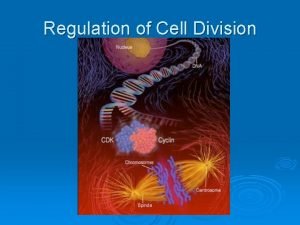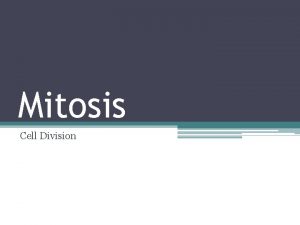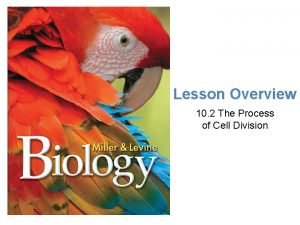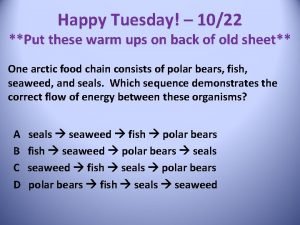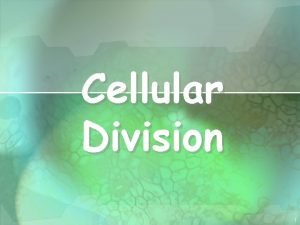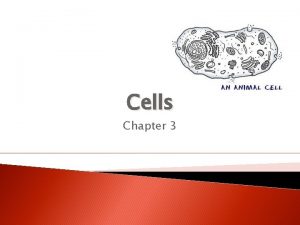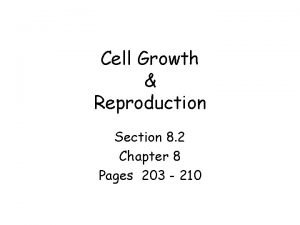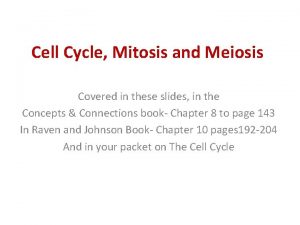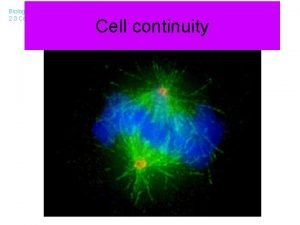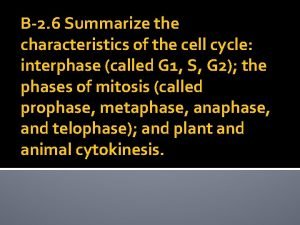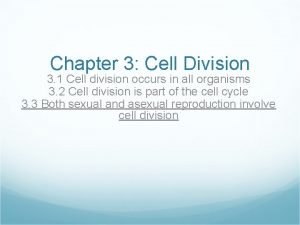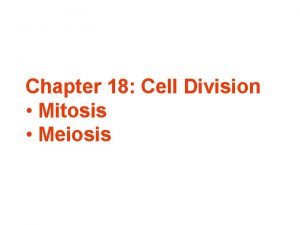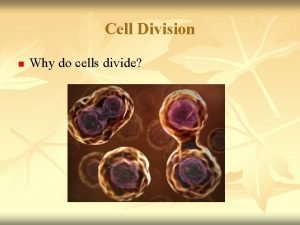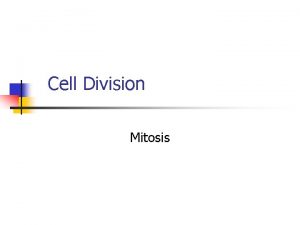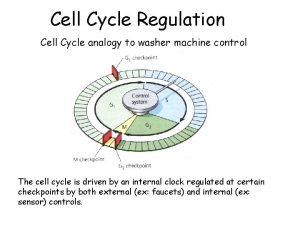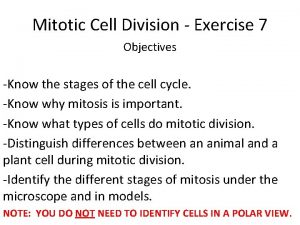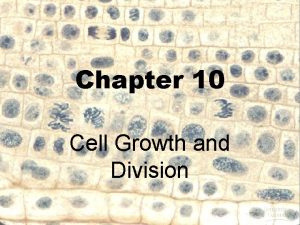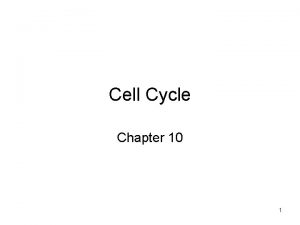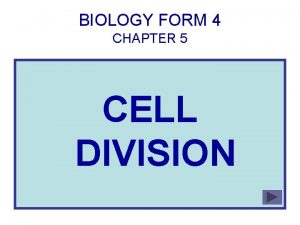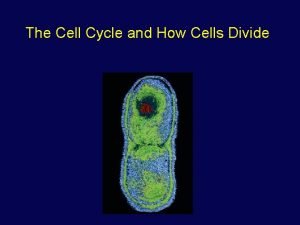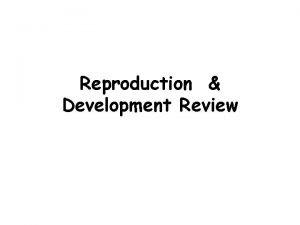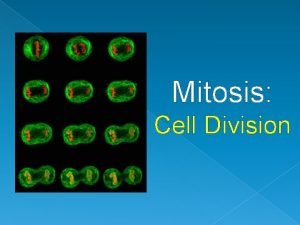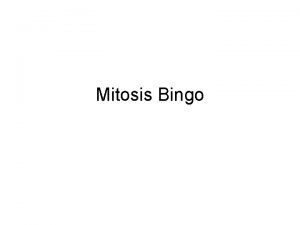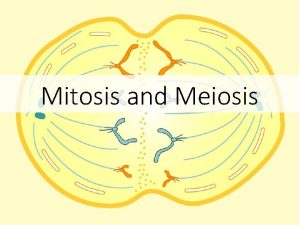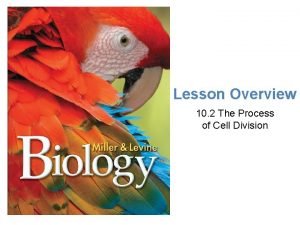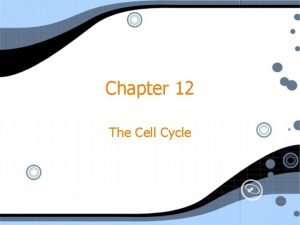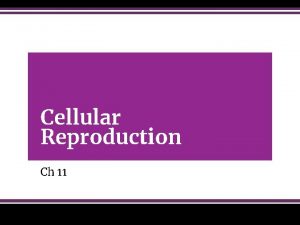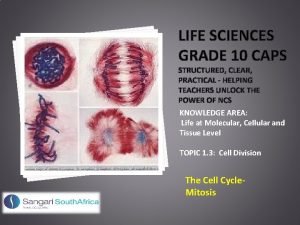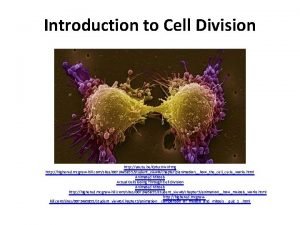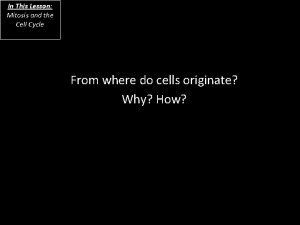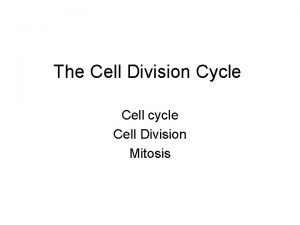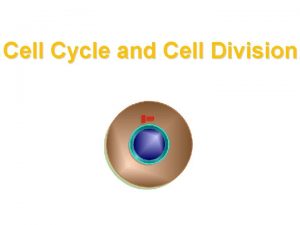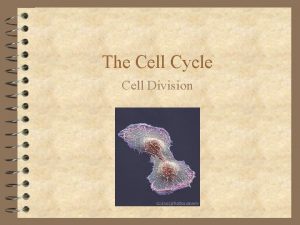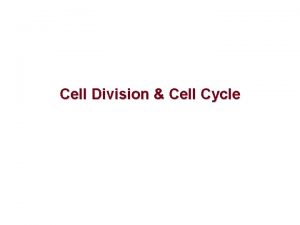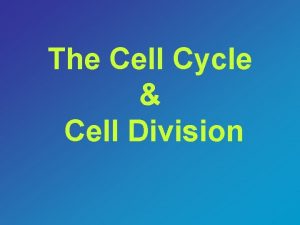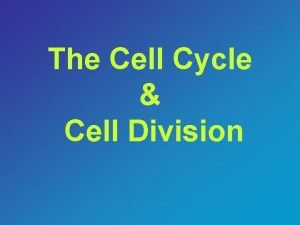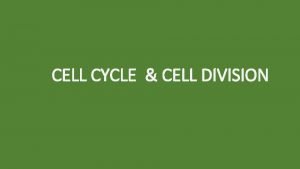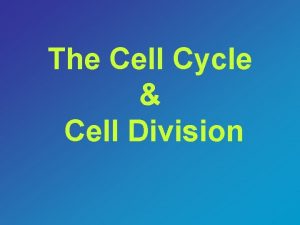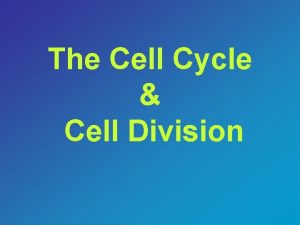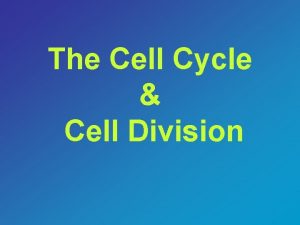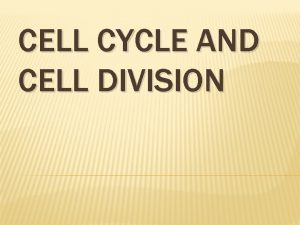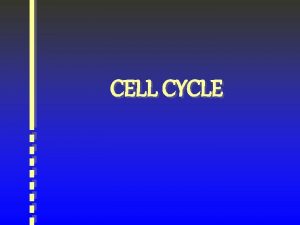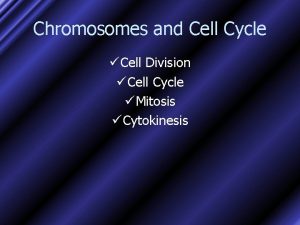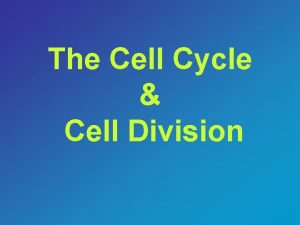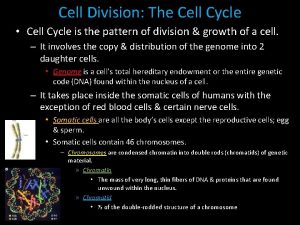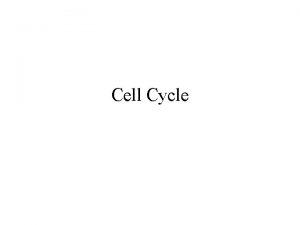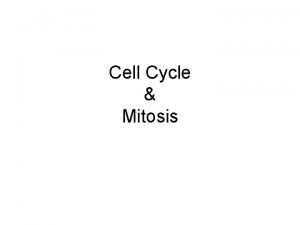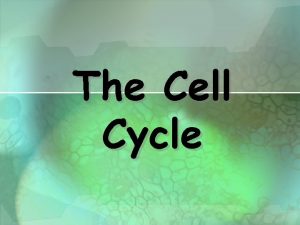The Cell Cycle Cell Division The Cell Cycle


















































- Slides: 50

The Cell Cycle & Cell Division

The Cell Cycle http: //www. nobel. se/medicine/laureates/2001/press. html

Phases of the Cell Cycle • The cell cycle consists of – Mitotic (M) phase (mitosis and cytokinesis) – Interphase (cell growth and copying of chromosomes in preparation for cell division) • Interphase (about 90% of the cell cycle) can be divided into subphases: – G 1 phase (“first gap”) – S phase (“synthesis”) – G 2 phase (“second gap”)

Animated Cycle http: //www. cellsalive. com/cell_cycle. htm

MITOSIS

Mitosis The process of cell division which results in the production of two daughter cells from a single parent cell. The daughter cells are identical to one another and to the original parent cell.

Mitosis can be divided into stages • Interphase • Prophase • Metaphase • Anaphase • Telophase & Cytokinesis

Interphase The cell prepares for division • Animal Cell – DNA replicated – Organelles replicated – Cell increases in size • Plant Cell – DNA replicated – Organelles replicated – Cell increases in size

Interphase Animal Cell Plant Cell Photographs from: http: //www. bioweb. uncc. edu/biol 1110/Stages. htm

Prophase The cell prepares for nuclear division • Animal Cell – Packages DNA into chromosomes • Plant cell – Packages DNA into chromosomes

Prophase Animal Cell Plant Cell Photographs from: http: //www. bioweb. uncc. edu/biol 1110/Stages. htm

Metaphase The cell prepares chromosomes for division • Animal Cell – Chromosomes line up at the center of the cell – Spindle fibers attach from daughter cells to chromosomes at the centromere • Plant Cell – Chromosomes line up at the center of the cell – Spindle fibers attach from daughter cells to chromosomes at the centromere

Metaphase Animal Cell Plant Cell Photographs from: http: //www. bioweb. uncc. edu/biol 1110/Stages. htm

Anaphase The chromosomes divide • Animal Cell – Spindle fibers pull chromosomes apart – ½ of each chromosome (called chromotid) moves to each daughter cell • Plant Cell – Spindle fibers pull chromosomes apart – ½ of each chromosome (called chromotid) moves to each daughter cell

Anaphase Animal Cell Plant Cell Photographs from: http: //www. bioweb. uncc. edu/biol 1110/Stages. htm

Telophase The cytoplasm divides • Animal Cell – DNA spreads out – 2 nuclei form – Cell wall pinches in to form the 2 new daughter cells • Plant Cell – DNA spreads out – 2 nuclei form – New cell wall forms between to nuclei to form the 2 new daughter cells

Telophase Animal Cell Plant Cell Photographs from: http: //www. bioweb. uncc. edu/biol 1110/Stages. htm

Mitosis Animation http: //www. cellsalive. com/mitosis. htm

Animal Mitosis -- Review Interphase Prophase Metaphase Anaphase Telophase Interphase

Plant Mitosis -- Review Interphase Prophase Metaphase Anaphase Telophase Interphase

Asexual Reproduction Living Environment

• Mitosis animation: • http: //brodylab. eng. uci. edu/cgibin/jpbrody/animation/files/6973887139. html

Are you two twins? • Asexual Reproduction: – Used by many unicellular organisms, plants, and lower animals. – Involves only mitotic cell division = each offspring has exactly the same heredity as its parent. – Usually rapid compared to sexual reproduction. Types of Asexual Reproduction Include:

Cut it half • Binary Fission = simplest form of asexual reproduction. Parent organism divides into two • approximately equal parts. Each daughter cell becomes a new individual.

Binary Fission

Bacteria • Bacteria – No organized nucleus. – Genetic material in the form a single circular chromosome. – Before division starts chromosome is replicated then each daughter cell gets one copy of the chromosome. – Can occur every 20 -min.

Protozoan • Protozoa – Mitosis occurs. Cytoplasm pinches in and divides the organism in half. Each half has a copy of the genetic material. Diagram.

• Protozoa – Mitosis occurs. Cytoplasm pinches in and divides the organism in half. Each half has a copy of the genetic material. Diagram.

They Where best buds • Budding = Parent organism divides into two unequal parts. • The new organism is created as a smaller out growth or bud on the outside of the parent. • Buds will brake off and live independently or remain attached and form a colony.

Budding

• Yeast – Once the yeast cell reaches a certain size it undergoes mitosis. • Once the genetic material is replicated budding begins. • Hydra – Cells on the outside of the parent hydra begin to undergo mitotic division creating a small group of cells. Those cells continue to divide until in a completely new hydra is formed. Can also reproduce sexually.

• Yeast cell cycle including budding: • http: //brodylab. eng. uci. edu/cgibin/jpbrody/animation/files/13977277560. html

Can I have some spore? • Spore Formation – spores = small specialized cells that contain a nucleus and cytoplasm surrounded by a thick outside wall which protects the spore. Under the right conditions the spore can rise to a new organism. Found in bacteria, molds, yeast, mushrooms, mosses, ferns and some protozoans.

Spore formation

Don’t try this at home • Regeneration = The ability to re-grow lost or damaged body parts. Hydra, planaria, starfish, and earthworm More complex animals less able to re-grow parts. Crab can re-grow a claw. Some reptiles can re-grow a tail. Most mammals can repair damaged tissue but can not re-grow missing parts.

Regeneration

Vegetative Reproduction

• Bulb = Short underground stem surrounded by thick leaves. Contain stored food. As the plant grows it produces new bulbs which will grow into new plants. Tulips, onions, and lilies.

• Corms = Similar to bulbs but do not contain leaves, just undergrou nd stems. Water chestnuts.

• Tuber = enlarged part of an underground stem that contains stored food. Potatoes are tubers. “Eyes” = tiny buds that can form a new potato plant. How you plant potatoes. Great potato famine.

• Runner or stolen = horizontal stem above the ground with buds. If a bud touches the ground it will form roots and stems and start a new plant. Strawberries.

• Rhizome = horizontal stem that grows underground. Thick and contains stored food. Upper portion form nodes which will form buds which will form new plants. Lower portion forms roots. Ferns, cattails, and water lilies.

Artificial Vegetative Reproduction

Watch out for those old ladies. • Cutting = use a portion of a developed plant to make a new plant. Roses, ivy, and grapevines are reproduced in this way.

• Layering = a stem is bent so that it is covered with soil. Once the branch forms roots it is disconnected from the original plant. Raspberries and roses.

• Grafting = Bud or stem of one plant is permanently attached to the stem or trunk of a very similar plant. The cambium layers grow together and form a single plant. Apple trees.

That’s a strange cacti

Why Bother? ? • Advantages to artificial vegetative propagation: 1. Plants that grow from seed are not always exactly the same as their parents. 2. Takes less time to artificially propagate. 3. Can create seedless fruits. 4. Grafting can be used to generate higher levels of fruit and nut production.

Can robot teachers from the future asexual reproduce? (Relax that was a rhetorical question)

Websites • Yeast cell cycle including budding: • http: //brodylab. eng. uci. edu/cgibin/jpbrody/animation/files/13977277560. html • Mitosis animation: • http: //brodylab. eng. uci. edu/cgibin/jpbrody/animation/files/6973887139. html
 Events of the cell cycle
Events of the cell cycle Cell cycle and cell division
Cell cycle and cell division Mitosis
Mitosis 369 times 2
369 times 2 Long division rational functions
Long division rational functions Short long division
Short long division Synthetic division polynomials
Synthetic division polynomials Biology.arizona.edu/cell bio/activities/cell cycle/01.html
Biology.arizona.edu/cell bio/activities/cell cycle/01.html Cell division acronym
Cell division acronym Frequency of cell division
Frequency of cell division Mitosis
Mitosis Why is cell division important
Why is cell division important What happens in prophase
What happens in prophase Ipmatc acronym ideas
Ipmatc acronym ideas Telophase
Telophase When cell division does not occur in the usual pattern a(n)
When cell division does not occur in the usual pattern a(n) Chapter 8 cell growth and division section 8-2 answer key
Chapter 8 cell growth and division section 8-2 answer key Mitosis sexual reproduction
Mitosis sexual reproduction Mitosis and meiosis
Mitosis and meiosis Cell furrow method
Cell furrow method Mitosis division
Mitosis division Cell continuity definition
Cell continuity definition Prophase characteristics
Prophase characteristics Sexual reproduction vs asexual reproduction venn diagram
Sexual reproduction vs asexual reproduction venn diagram Sentromer
Sentromer Two cells are produced
Two cells are produced Unicellular cell division
Unicellular cell division Aster cell division
Aster cell division Why do cells divide? *
Why do cells divide? * Cell division vocabulary
Cell division vocabulary Cell cycle analogy
Cell cycle analogy Prophase microscope
Prophase microscope Telopahse
Telopahse Section 10-1 cell growth
Section 10-1 cell growth Cell division
Cell division Cell cycle mind map
Cell cycle mind map New 100 dollar
New 100 dollar Cell division
Cell division Interphase
Interphase Cell division
Cell division Mitosis in whitefish and onion roots
Mitosis in whitefish and onion roots Mitosis
Mitosis Duplicated chromosomes
Duplicated chromosomes What happens during telophase?
What happens during telophase? Cell division
Cell division Cell division
Cell division Cell division
Cell division Importance of mitosis
Importance of mitosis Cell division
Cell division Interesting facts about mitosis
Interesting facts about mitosis Henning kurz
Henning kurz









